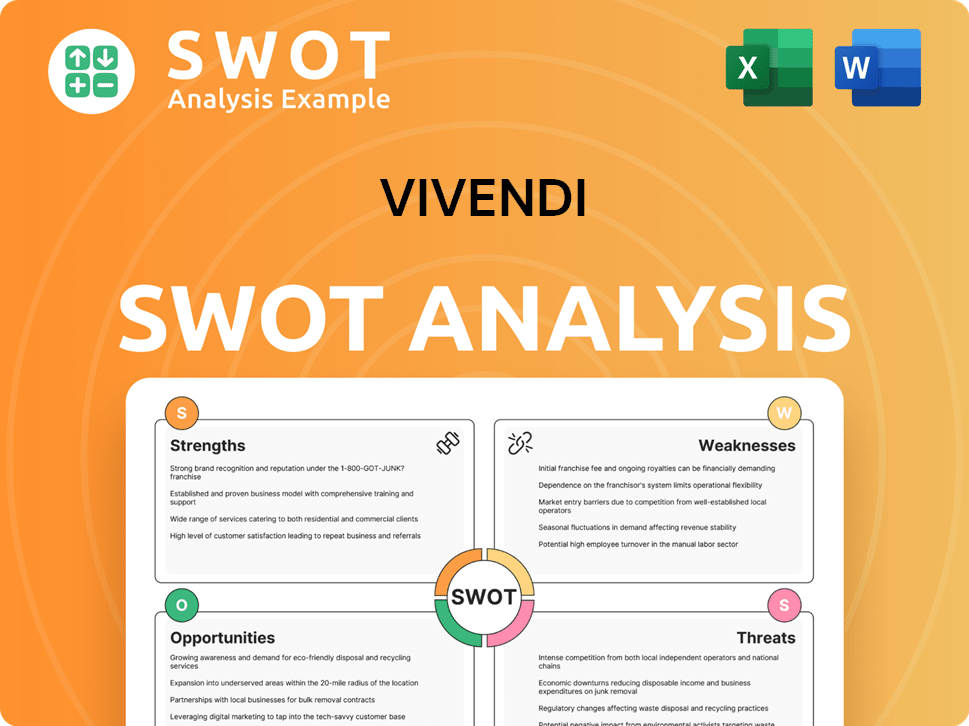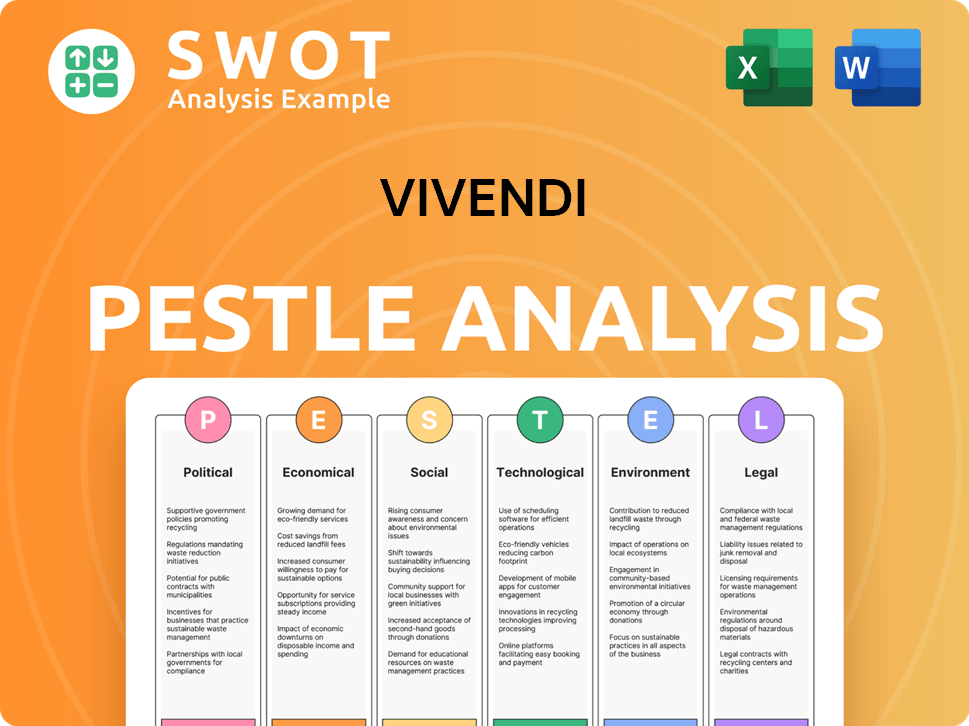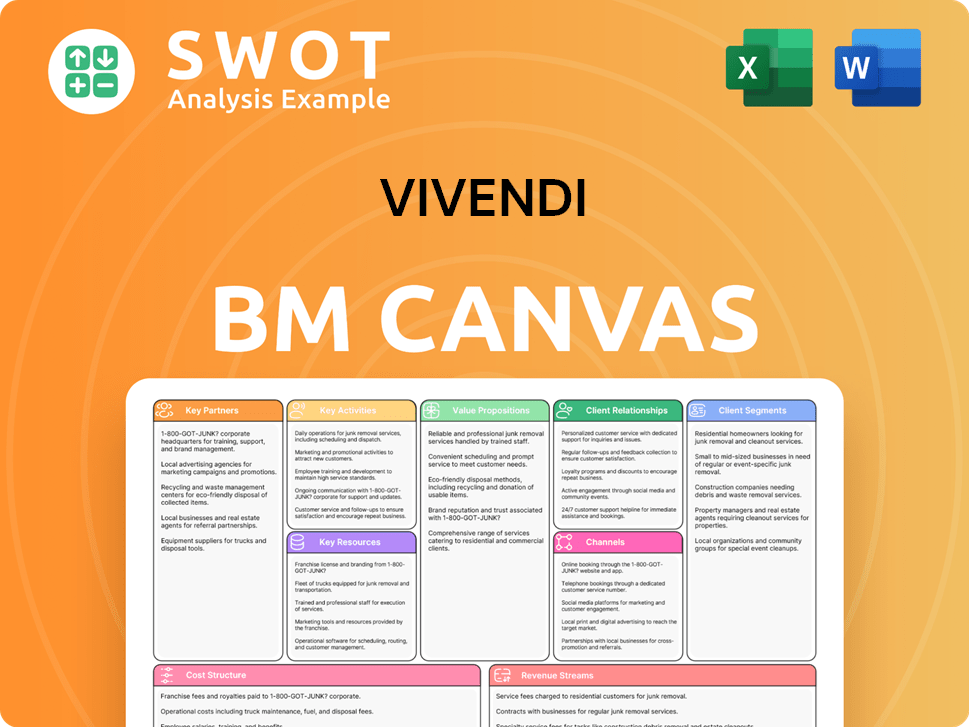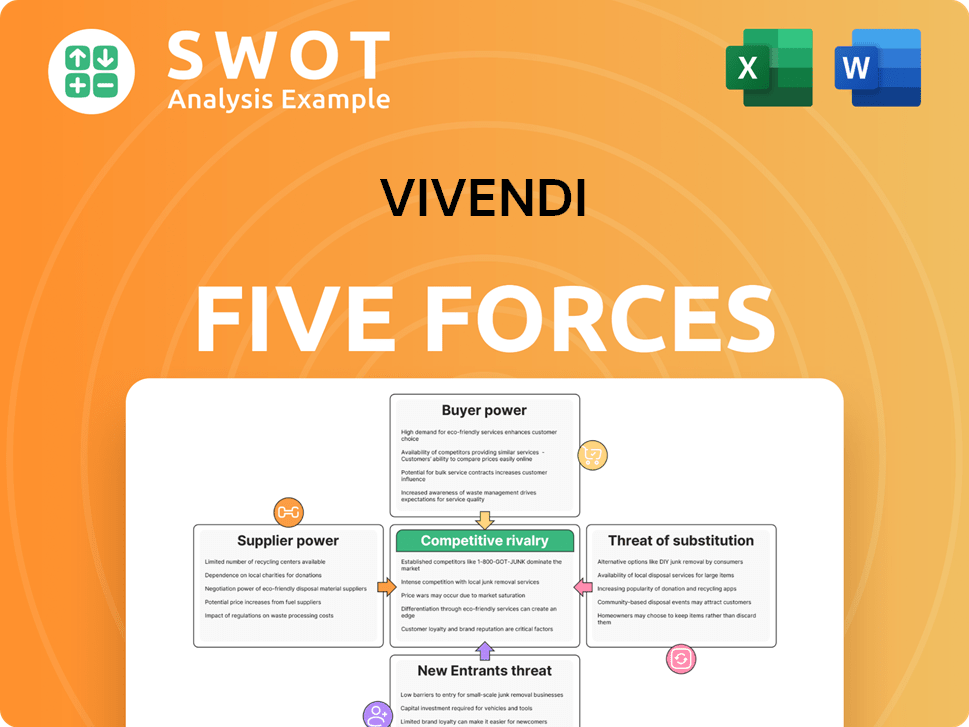Vivendi Bundle
Can Vivendi's Growth Strategy Propel It to New Heights?
Vivendi, a media and content giant, is navigating the complex entertainment landscape with a dynamic growth strategy. The acquisition of Lagardère in late 2023 marked a significant shift, expanding its reach in publishing and travel retail. This article delves into Vivendi's transformation from its origins to its current market position, exploring its ambitious plans for the future.

To understand Vivendi's trajectory, we'll examine its Vivendi SWOT Analysis, strategic initiatives, and how it's adapting to digital disruption. We will also look at the company's financial performance and outlook. This comprehensive Vivendi company analysis will provide valuable insights into its long-term growth potential and competitive landscape, offering a clear view of its future prospects.
How Is Vivendi Expanding Its Reach?
The Vivendi growth strategy heavily relies on strategic expansion initiatives. These initiatives focus on broadening its geographical reach and diversifying its content and service offerings. The company aims to strengthen its market position and explore new avenues for revenue generation.
A significant move in this strategy was the acquisition of Lagardère, finalized in November 2023. This acquisition significantly bolstered Vivendi's publishing arm through Hachette Livre and expanded its presence in travel retail. Such moves are designed to diversify revenue streams and enhance market leadership in key content areas. This is a part of Vivendi's strategic initiatives.
Vivendi's approach includes prioritizing international expansion for its Canal+ Group, particularly in Africa and Asia. The goal is to tap into new customer bases and capitalize on growing media consumption in these regions. The company is also actively exploring new business models, such as subscription-based services and targeted advertising, to adapt to changing consumer behaviors and industry trends.
Canal+ Group continues to grow its subscriber base outside of mainland France, indicating successful penetration into new markets. Vivendi is focusing on expanding its presence in Africa and Asia. These regions offer significant growth potential due to increasing media consumption.
The acquisition of Lagardère in 2023 is a prime example of Vivendi's diversification strategy. This move strengthens Vivendi's position in publishing through Hachette Livre. The company is also exploring new business models, including subscription services and targeted advertising.
Vivendi continually evaluates potential mergers and acquisitions. These are aimed at consolidating its market position. The company seeks to gain access to innovative technologies or intellectual property.
Vivendi is actively adapting to digital disruption. This includes focusing on subscription-based services and targeted advertising. The company’s strategy is to align with evolving consumer behaviors and industry trends.
Vivendi's key growth drivers include geographical expansion, particularly in Africa and Asia. Diversification of content and services through acquisitions and new business models is also crucial. The company's ability to adapt to digital trends and consumer behavior is essential for its Vivendi future prospects.
- Expansion of Canal+ Group in international markets.
- Strategic acquisitions to strengthen content offerings.
- Development of subscription-based services.
- Focus on targeted advertising.
Vivendi SWOT Analysis
- Complete SWOT Breakdown
- Fully Customizable
- Editable in Excel & Word
- Professional Formatting
- Investor-Ready Format

How Does Vivendi Invest in Innovation?
Vivendi's Vivendi growth strategy heavily relies on innovation and technology to maintain its competitive edge. The company strategically invests in research and development across its various business units, focusing on digital platforms, content creation, and distribution. This approach is crucial for adapting to the rapidly evolving media landscape and driving future growth.
Vivendi's future prospects are closely tied to its ability to leverage technological advancements. By embracing new technologies like AI and exploring emerging markets, Vivendi aims to optimize operations, enhance audience engagement, and expand its global reach. This commitment is evident in its strategic initiatives across different sectors.
The Vivendi company analysis reveals a consistent focus on innovation. This is particularly apparent in the development of its digital platforms and the exploration of new technologies like cloud gaming and virtual reality by its subsidiaries. This forward-thinking approach is designed to ensure long-term sustainability and profitability.
Canal+ Group continuously develops its streaming platforms and digital offerings. This includes features that leverage data analytics for personalized content recommendations. This enhances user experience and accessibility.
Havas, Vivendi's communications arm, focuses on data-driven marketing and AI-powered insights. It uses programmatic advertising to deliver more effective campaigns for its clients. This approach increases marketing efficiency.
Gameloft consistently innovates with new game development, exploring technologies like cloud gaming and VR. This strategy aims to create immersive experiences and reach broader audiences. This expands market reach.
Vivendi explores the potential of AI and other cutting-edge technologies. This is to optimize content production and enhance audience engagement. It also streamlines operational efficiencies across its business units.
Vivendi invests in research and development to enhance its digital platforms. This includes content creation and distribution capabilities. This ensures a competitive edge.
The company focuses on streamlining operational efficiencies. It aims to optimize content production using AI and other cutting-edge technologies. This enhances profitability.
Vivendi's commitment to innovation and technology is a core element of its Vivendi business model. By focusing on digital transformation, data-driven strategies, and emerging technologies, Vivendi aims to maintain a strong Vivendi market position and achieve sustained growth. For more insights into the company's structure, you can explore Owners & Shareholders of Vivendi.
Vivendi's strategic initiatives are centered on digital transformation and technological advancements. These initiatives are designed to drive growth and maintain a competitive edge in the media and entertainment industry.
- Digital Platform Development: Continuous enhancements to streaming platforms and digital offerings to improve user experience.
- Data Analytics: Leveraging data analytics for personalized content recommendations and targeted marketing.
- AI Integration: Exploring AI for content production optimization and audience engagement.
- Emerging Technologies: Investing in cloud gaming, virtual reality, and other cutting-edge technologies.
- Data-Driven Marketing: Utilizing data-driven insights and programmatic advertising for more effective campaigns.
Vivendi PESTLE Analysis
- Covers All 6 PESTLE Categories
- No Research Needed – Save Hours of Work
- Built by Experts, Trusted by Consultants
- Instant Download, Ready to Use
- 100% Editable, Fully Customizable

What Is Vivendi’s Growth Forecast?
Vivendi's financial outlook is shaped by its ambitious growth strategy and the performance of its diverse business segments. The company aims to sustain revenue growth and maintain healthy profit margins. This approach is underpinned by strategic investments and a focus on expanding its market presence.
For the full year 2023, Vivendi reported revenues of €10.5 billion, marking a 2.5% increase compared to 2022. This positive trajectory is a key indicator of the company's financial health and its ability to execute its strategic initiatives effectively. The company's financial strategy emphasizes disciplined capital allocation and optimizing profitability while pursuing strategic opportunities.
The company's diversified portfolio, including Canal+ Group and Havas, plays a crucial role in its financial performance. Canal+ Group saw a significant rise in subscribers and revenues in 2023, contributing substantially to Vivendi's overall financial well-being. Havas also demonstrated robust growth, benefiting from its focus on digital and data-driven marketing.
Vivendi's revenue increased by 2.5% in 2023, reaching €10.5 billion. This growth reflects the company's ability to capitalize on market opportunities and expand its business segments.
Vivendi continues to invest in content creation, technological infrastructure, and strategic acquisitions. These investments are crucial for sustaining long-term growth and enhancing shareholder value.
Canal+ Group and Havas are key contributors to Vivendi's financial success. Canal+ reported increased subscribers and revenues, while Havas benefited from its focus on digital marketing.
Analyst forecasts generally anticipate stable to moderate revenue growth for Vivendi in the coming years. This is driven by its diversified portfolio and expansion initiatives, as well as the company's target market.
Vivendi's financial strategies are centered on disciplined capital allocation and optimizing profitability. These strategies are crucial for achieving sustainable growth and enhancing shareholder value.
- Investment in content creation to drive revenue.
- Technological advancements to improve operational efficiency.
- Strategic acquisitions to expand market presence.
- Focus on digital and data-driven marketing.
Vivendi Business Model Canvas
- Complete 9-Block Business Model Canvas
- Effortlessly Communicate Your Business Strategy
- Investor-Ready BMC Format
- 100% Editable and Customizable
- Clear and Structured Layout

What Risks Could Slow Vivendi’s Growth?
The growth trajectory of Vivendi, a prominent player in the media and content industry, faces several potential risks and obstacles. These challenges range from intense competition and regulatory changes to technological disruptions and internal management complexities. Successfully navigating these hurdles is crucial for realizing Vivendi's ambitious growth plans and maintaining its market position.
Intense competition, especially from global streaming giants and tech companies, presents a significant hurdle for Vivendi. Regulatory shifts, particularly concerning media ownership and data privacy, could impact operations across different geographical markets. Additionally, evolving consumer preferences and the rising costs of premium content pose ongoing challenges for the company's future trajectory.
Vivendi's strategic initiatives are also subject to operational risks, including supply chain vulnerabilities, which can affect content production and distribution. The company must continuously adapt to technological advancements, such as AI and new content consumption models, to avoid obsolescence. Managing a diverse portfolio of businesses also presents resource allocation challenges and requires effective synergy across the group.
The media and content industry is highly competitive, with major players like Netflix, Disney, and Amazon investing heavily in content creation and distribution. This competition puts pressure on Vivendi's market share and profitability. The company must continually innovate and invest in high-quality content to remain competitive.
Changes in media ownership regulations, content distribution rules, and data privacy laws can significantly impact Vivendi's operations. Compliance with these regulations across different geographical markets requires significant resources and strategic adjustments. Any failure to comply could result in financial penalties or operational restrictions.
Rapid advancements in technology, such as the rise of AI and new content consumption models, require continuous adaptation. Vivendi must invest in new technologies and distribution platforms to stay relevant. Failure to adapt could lead to a loss of market share and revenue.
While less prominent than in manufacturing, supply chain issues can still affect content production and distribution. Disruptions in the supply of specific technologies or international collaborations can impact Vivendi's ability to deliver content on time and within budget. The company needs robust contingency plans to mitigate these risks.
Managing a diverse portfolio of businesses, each with unique market dynamics, presents internal challenges. Effective resource allocation and fostering synergy across the group are critical. Inefficient management can lead to missed opportunities and decreased profitability. The company's ability to streamline operations and foster collaboration is crucial.
Consumer preferences are constantly evolving, with new content formats and consumption habits emerging regularly. Vivendi must anticipate these shifts and adapt its content offerings and distribution strategies accordingly. Ignoring these changes could lead to a decline in audience engagement and revenue. Understanding and responding to these trends is essential for long-term success.
Vivendi employs several strategies to mitigate these risks. Diversification across various media sectors helps spread risk. Robust risk management frameworks and proactive scenario planning are essential. For example, the company's acquisition of Lagardère required navigating complex regulatory environments. Investments in cybersecurity are also crucial to protect digital assets and customer data. These measures are key to safeguarding Vivendi's future prospects.
As of 2024, Vivendi's financial performance reflects its strategic initiatives. The company's revenue streams and business model, as detailed in Revenue Streams & Business Model of Vivendi, are crucial for understanding its financial health. The company's ability to maintain and grow its revenue depends on its ability to navigate the challenges outlined above. The company’s long-term growth potential hinges on its ability to adapt and innovate.
Vivendi Porter's Five Forces Analysis
- Covers All 5 Competitive Forces in Detail
- Structured for Consultants, Students, and Founders
- 100% Editable in Microsoft Word & Excel
- Instant Digital Download – Use Immediately
- Compatible with Mac & PC – Fully Unlocked

Related Blogs
- What are Mission Vision & Core Values of Vivendi Company?
- What is Competitive Landscape of Vivendi Company?
- How Does Vivendi Company Work?
- What is Sales and Marketing Strategy of Vivendi Company?
- What is Brief History of Vivendi Company?
- Who Owns Vivendi Company?
- What is Customer Demographics and Target Market of Vivendi Company?
Disclaimer
All information, articles, and product details provided on this website are for general informational and educational purposes only. We do not claim any ownership over, nor do we intend to infringe upon, any trademarks, copyrights, logos, brand names, or other intellectual property mentioned or depicted on this site. Such intellectual property remains the property of its respective owners, and any references here are made solely for identification or informational purposes, without implying any affiliation, endorsement, or partnership.
We make no representations or warranties, express or implied, regarding the accuracy, completeness, or suitability of any content or products presented. Nothing on this website should be construed as legal, tax, investment, financial, medical, or other professional advice. In addition, no part of this site—including articles or product references—constitutes a solicitation, recommendation, endorsement, advertisement, or offer to buy or sell any securities, franchises, or other financial instruments, particularly in jurisdictions where such activity would be unlawful.
All content is of a general nature and may not address the specific circumstances of any individual or entity. It is not a substitute for professional advice or services. Any actions you take based on the information provided here are strictly at your own risk. You accept full responsibility for any decisions or outcomes arising from your use of this website and agree to release us from any liability in connection with your use of, or reliance upon, the content or products found herein.